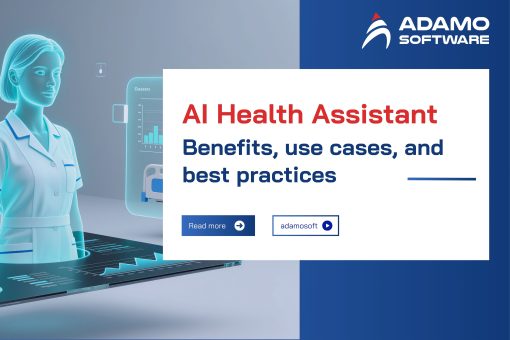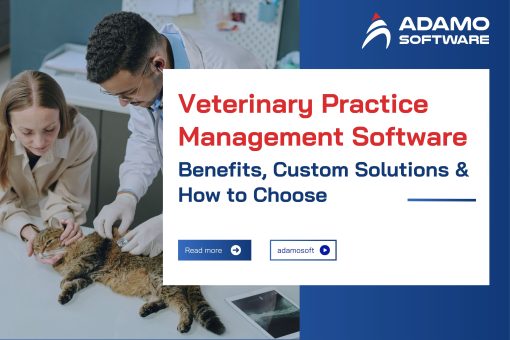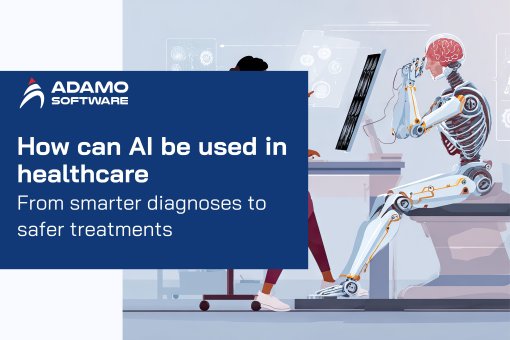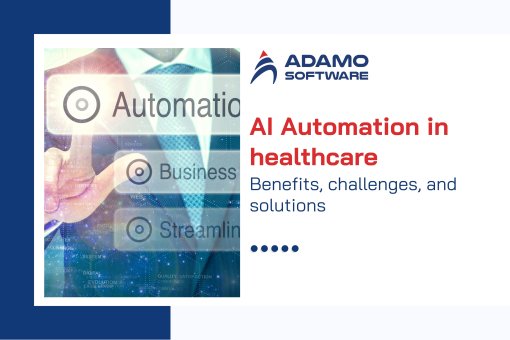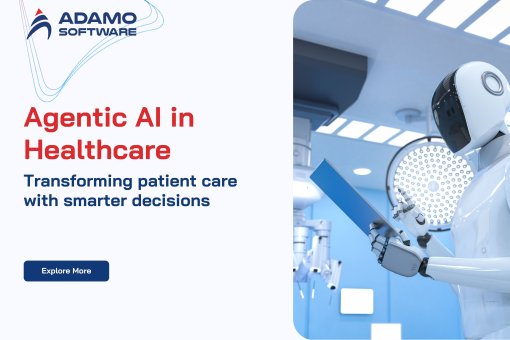Telemedicine in Pediatrics: Benefits & Best Tools for 2026
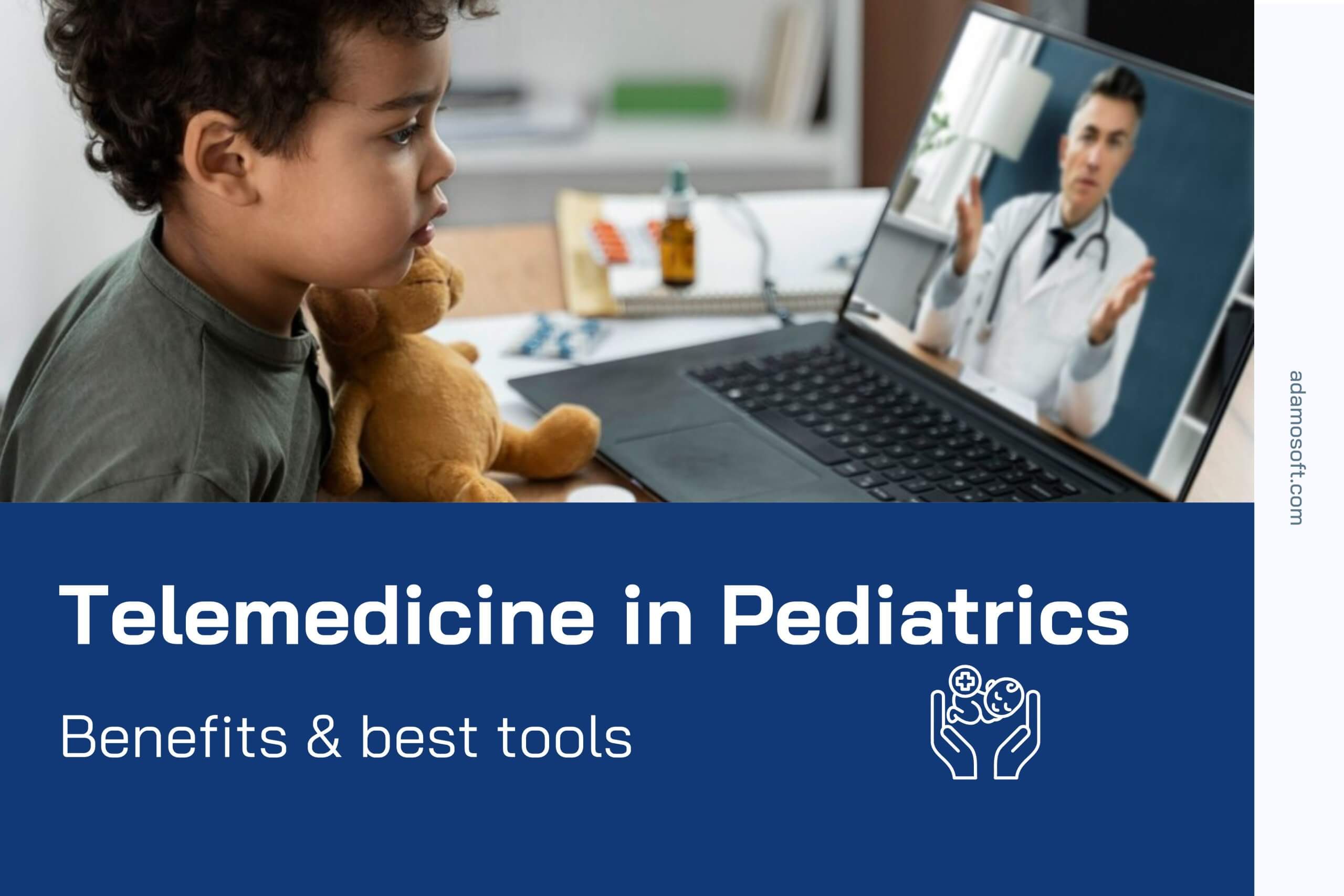
Telemedicine in pediatrics is extremely beneficial to both healthcare providers and patients. Let’s explore this technology with Adamo Software!
Since the COVID-19 pandemic, the demand for flexible healthcare solutions that allow patients to be treated remotely has promoted the use of telehealth technologies. In the future, this industry is projected to grow at a high rate, thanks to the popularity of mobile devices, IoT in healthcare, and artificial intelligence (AI). Telemedicine is applied in many hospital departments, including pediatrics. Thanks to its convenience and safety, telemedicine in pediatrics helps parents and pediatricians monitor children’s health without having to go directly to a medical facility. Let’s explore this technology with Adamo Software!
Through this blog post, you will know the rise of telemedicine in pediatrics and the benefits of telemedicine in pediatrics. Besides, Adamo Software also discusses 9 software solutions to integrate telemedicine in pediatrics for better pediatrics. All information has been thoroughly researched and updated to the latest trends. So, let’s read our blog post and find some useful information!
I. The rise of Telemedicine in Pediatrics
Recently, telemedicine app development solution has emerged as a significant trend in the global healthcare landscape, especially within pediatrics. The combination of significant information technology development and the requirement for flexible medical care has resulted in the rapid application of telemedicine services to assist in the diagnosis, monitoring, and treatment of children of different age groups.
By providing video consultations, symptom tracking, and vaccination reminders, telemedicine helps parents avoid travel burdens, save time, and connect with doctors more efficiently. It is projected that telemedicine in pediatrics will continue to grow strongly, with the continuous improvement of technologies such as artificial intelligence (AI), Internet of Things in Medicine (IoMT) and electronic health record (EHR) platforms. This will become an indispensable part of the comprehensive healthcare system for children around the world.
The telemedicine in pediatrics market is growing significantly, with a compound annual growth rate (CAGR) expected to reach 26.1% between 2024 and 2031 globally. In the United States, about 17 million children face the challenge of living more than an hour from the nearest pediatric hospital. This emphasizes the urgency for telemedicine interventions. Notably, 85% of children and adolescents expressed satisfaction with their telemedicine experience. This shows that this age group highly accepts this modern healthcare technology. Additionally, 76.7% of primary care physicians reported that the quality of care delivered via virtual appointments was like that of in-person visits. Thus, pediatric patients and their families will have more faith in the effectiveness and safety of telemedicine in pediatrics.
II. Benefits of Telemedicine in pediatrics
Telemedicine in pediatrics benefits both patients and healthcare providers. Let Adamo Software discuss some outstanding benefits of this technology.
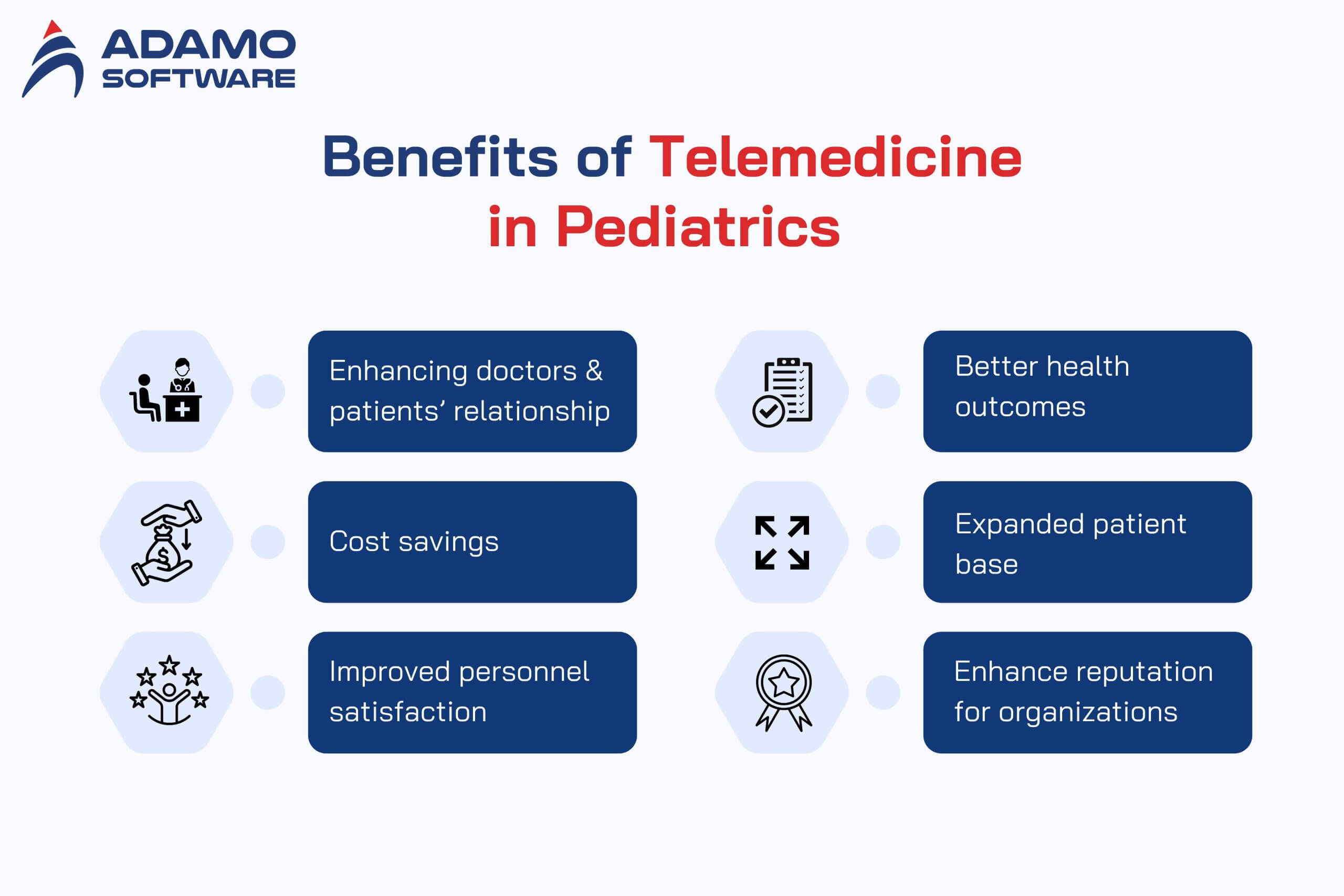
Enhancing doctors and patients’ relationship
Telemedicine in pediatrics enhances the relationship between doctors and patients. Thanks to this technology’s flexible connectivity, doctors can closely monitor a child’s health. They can conduct frequent online check-ups, supporting continuous care. Regular and accessible communication helps parents feel more secure and allows children to build familiarity and trust with their doctor through repeated interactions.
Besides, children will feel more comfortable and less anxious when they are at home and receive home medical care services. Thanks to this, doctors can observe children’s behavior, living environment, and daily routes. This may be hard to see in direct examination at the hospital. This comprehensive understanding enables doctors to give informed and individualized advice, fostering a strong and lasting partnership among doctors, children, and their families.
Additionally, children may feel stressed and confused when they have to change doctors or nurses frequently. Therefore, they may not want to cooperate with doctors and their treatments, thereby reducing mental health outcomes. In this case, telemedicine in pediatrics is essential. Thanks to this technology, children can meet the same doctor and medical team each time they have a medical examination. This consistency makes children feel more secure and keeps their emotions stable. When children trust doctors, their parents will also trust them. All of this may contribute to improving children’s long-term health outcomes.
Cost savings
Cost savings are also among the advantages of telemedicine in pediatrics. When children and their parents take an online consultant, they will not have to transfer to the hospital. Thus, they can save travel and gas costs. Telemedicine in pediatrics is extremely essential for families living far from the hospitals.
With this technology, parents won’t have to arrange time to take their children to the hospital. Instead, they can stay at home to meet doctors online. They can ask doctors to examine and diagnose their children’s illness through video calls.
Moreover, telemedicine offers a more affordable alternative to emergency/hospital visits for common pediatric issues. They include mild fevers, coughs, allergies, rashes, nutrition/development, etc. Thanks to modern technology, parents can manage the costs of treatment for their children more effectively.
Improved personnel satisfaction
Telemedicine in pediatrics also helps to improve healthcare staff satisfaction. With online consultation, doctors will have more time for patients and reduce stress. Telemedicine enables doctors to work in a less stressful environment. This enables them to balance their life and work.
In addition, telemedicine reduces the administrative process for pediatricians. Thanks to this, they can see more patients in less time. This enhances their focus on expertise, improving efficiency and contribution. When medical professionals feel supported and benefit from a flexible and efficient workplace, the standard of care they provide to children also naturally improves.
Better health outcomes
Telemedicine in pediatrics enhances medical treatment quality and long-term health outcomes for children. This technology allows pediatricians to closely monitor disease progression, intervene quickly at any abnormalities, and adjust treatment as needed. Urgent care through telemedicine apps can result in less severe illnesses and quicker recoveries.
Remote monitoring reduces the need for frequent pediatric emergency room visits. The telemedicine in pediatrics apps will provide important notices to remind patients of their health check-up appointment. Especially for chronic conditions such as asthma or developmental disorders, the frequency of follow-up will be increased.
In addition, telemedicine in pediatrics also improves treatment compliance for pediatric patients and their families. Easy access to doctors encourages parents to follow advice and identify problems early. When children receive healthcare at home, they will feel more comfortable than in the hospital. This makes the recovery process more effective. Overall, pediatric telemedicine helps ensure comprehensive, continuous care for optimal treatment results.
Expanded patient base
Flexible schedules and increased accessibility allow doctors to accommodate more consultations. Moreover, healthcare providers can establish convenient care options for children with complex medical needs. In such situations, telemedicine in pediatrics allows for faster diagnosis and treatment, reduces expenses, and helps avoid unexpected hospital stays.
Telemedicine in pediatrics allows children, particularly in remote or resource-limited areas with transportation difficulties, to access healthcare. Internet-connected devices allow children everywhere to get medical advice and diagnoses. This technology also allows medical facilities to reach more patients beyond their physical locations. Doctors can increase efficiency by consulting patients in diverse locations daily, ensuring quality care. Ultimately, these factors greatly enhance the patient and family experience, fostering greater reliance on telemedicine in pediatrics solutions in the future.
Enhancing reputation for healthcare organizations
By reducing wait times and unnecessary visits to waiting rooms, telemedicine maximizes convenience for patients. This contributes to enhancing a healthcare organization’s reputation. Through more efficient care and better triage, telemedicine helps pediatricians offer equitable opportunities across diverse socioeconomic, cultural, and geographical contexts.
Moreover, by enabling regular communication, close patient monitoring, and remote quality assurance, telemedicine in pediatrics strengthens the professional and dedicated image of the medical team. Organizations that invest in telehealth are also often more highly regarded for their innovation, ability to meet real needs, and sustainable development orientation. Consequently, they can attract more patients and gain an advantage with partners, regulators, and investors in healthcare. Ultimately, pediatric telecare aims to build a patient-focused experience that can determine families’ choice of long-term healthcare provider for their children.
Generally, telemedicine in pediatrics provides many practical benefits for caregivers and patients, including stronger doctor-child bonds and family cost savings. This technology also helps improve overall healthcare outcomes through continuous home monitoring and prompt treatment for children. Telemedicine’s flexibility and remote connectivity enable broader patient reach, especially in areas with limited medical access. Finally, by effectively implementing telehealth services, medical organizations can enhance their reputation and professional image.
III. 9 software solutions to integrate with Telemedicine Pediatrics for better efficiency
Telemedicine in pediatrics must be integrated with some advanced software solutions to maximize its benefits. These integrations ensure comprehensive, efficient, and seamless healthcare by improving communication, data handling, and patient support. Let Adamo Software recommend the top 09 software solutions to integrate with telemedicine pediatrics for better efficiency.
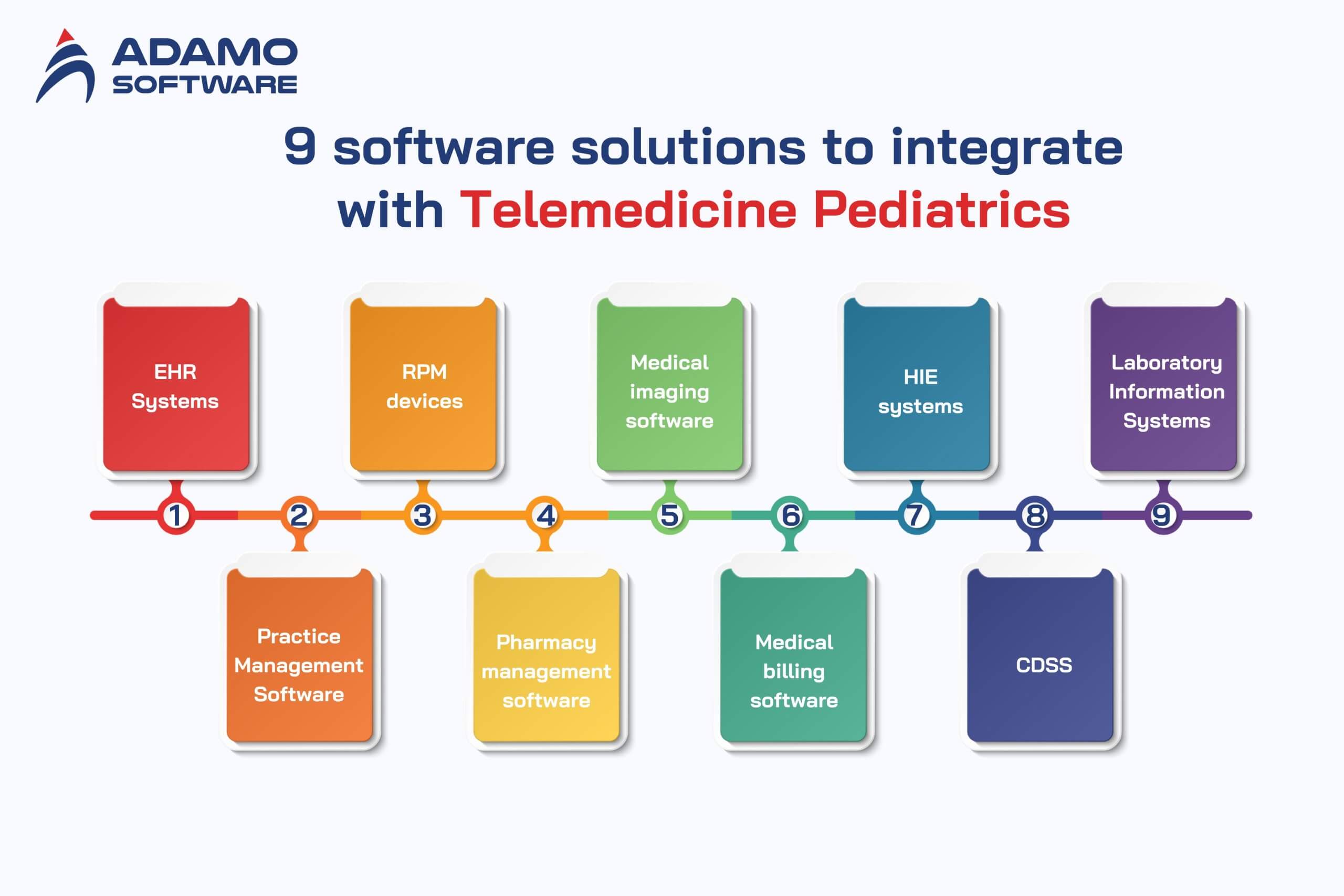
Electronic Health Records (EHR) Systems
Electronic health records (EHRs) are digital health records commonly used by healthcare facilities. It is a collection of an individual’s health data stored on an electronic system. Every individual can have a comprehensive digital health record, containing important information such as demographics, medical history, prescriptions and treatment regimens, doctor’s notes, test results, etc. Also, medical histories and diagnoses are stored in the EHR.
By combining telemedicine in pediatrics with EHR systems, healthcare facilities can improve the effectiveness of pediatric care significantly. Electronic records are accessible to both public health care providers and owners. They allow doctors to access all of a child’s health information online. They include medical history, prescriptions, test results, and notes from previous visits. Thanks to this, doctors can provide quicker diagnosis. Besides, they can prevent medication errors or redundant tests and ensure consistent and accurate treatment.
By linking telemedicine with the EHR system, doctors can readily monitor treatment progress at each visit. In addition, they can modify the plan when necessary. This reduces dependence on parents’ memory. Real-time data synchronization across departments enhances coordination and enables more effective clinical decisions. Some popular EHR systems include Epic, Cerner, Allscripts, and eClinicalWorks.
Practice Management Software (PMS)
Practice Management Software (PMS) is an advanced technology that helps clinics manage medical examination and treatment services and internal operations. By enabling process optimization, management software offers significant advantages to the clinic. PMS helps to increase operational efficiency, reduce manual work, and save time and resources. Besides, it also enhances patient experience and supports leadership decisions. It streamlines daily operations like scheduling, billing, and other administrative tasks.
With PMS integration, pediatric telemedicine streamlines and professionalizes operations, saving time for staff and families. Through the integrated PMS, parents can easily schedule remote appointments and receive reminders, e-invoices, and pre-visit instructions. After online consultations, the system automatically updates profiles, processes claims, and manages prescriptions. This helps to save time and reduce manual data entry errors. You can integrate your telemedicine in the pediatrics system with Kareo, athenahealth, NextGen Healthcare, Greenway Health, etc.
Remote Patient Monitoring (RPM) Devices
Remote Patient Monitoring tools enable healthcare providers to track patients’ conditions outside of conventional clinical environments, like their homes. RPM devices collect a range of patient health data directly, like weight, blood pressure, blood sugar, and electrocardiograms. By combining telemedicine in pediatrics with RPM devices, you can enhance the quality of care and the ability to monitor children’s health status. RPM devices like heart rate, temperature, blood pressure, oxygen saturation, and blood sugar monitors let patients transmit health data directly to doctors via telemedicine.
The integration of telemedicine in pediatrics and RPM devices is especially useful for children with chronic conditions. Doctors can quickly spot abnormalities and adjust treatment promptly with continuous RPM data, without waiting for regular check-ups. Popular RPM tools include Philips Remote Patient Monitoring, Health Recovery Solutions, Medtronic Care Management Services, BioTelemetry, etc.
Pharmacy Management Software
Telemedicine in pediatrics can also be integrated with Pharmacy Management Software. This software streamlines pharmacy operations by efficiently managing inventory, processing prescriptions, and handling billing. Pharmacies can ensure precise dispensing, track stock, and improve customer service by using this software.
The combination of pediatric telemedicine and pharmacy management software streamlines, ensures accuracy, and improves convenience for dispensing and tracking children’s medications. The software automates prescribing, inventory checking, insurance processing, and medication delivery. Once the pediatrician completes the consultation via the telemedicine platform, the prescription can be sent directly to the integrated pharmacy management system. The software will check the availability of the medication, check for drug interactions (if any), process insurance payments, and arrange for home delivery to the child.
For doctors and medical facilities, this integration helps reduce prescription errors and shorten post-examination processing times. For pharmacies, the system helps manage inventory better, easily track order history, and optimize operations. You may want to integrate your telemedicine in pediatrics software with PioneerRX, McKesson EnterpriseRx, QS/1 Pharmacy Management, Liberty Software, and PrimeRx.
Medical Imaging Software
Medical imaging software provides the tools to create, store, and analyze images of the human body for clinical interpretation. With its ability to produce detailed visuals like X-rays, MRIs, and CT scans, this software is indispensable for the diagnosis and monitoring of diverse medical conditions. By integrating with medical imaging software, your telemedicine in pediatrics software can help doctors diagnose and monitor children’s health more accurately.
Through the telemedicine in pediatrics platform, diagnostic imaging results are sent and stored on the software system. This enables doctors to access, analyze and discuss with parents during the remote examination. Advanced software also integrates AI technology to support early detection of abnormalities on images, thereby increasing the accuracy of assessment and shortening the time to make treatment decisions. Common medical imaging software includes GE Healthcare Centricity, Philips IntelliSpace, Siemens Syngo, Agfa HealthCare Enterprise Imaging, and FujiFilm Synapse.
Medical Billing Software
Medical billing software streamlines the billing process by automating claim submissions, tracking payments, and managing patient invoices. This helps ensure that healthcare providers receive accurate and timely payments for the services they provide. When telemedicine in pediatrics is integrated with medical billing software, the billing process becomes more transparent, accurate, and easier for both parents and medical facilities.
The telemedicine system automates the post-consultation process by generating an invoice based on services, linking it to patient records, and directly transmitting the information to the insurance company if needed. This saves parents time in processing procedures and reduces errors due to manual data entry. Simultaneously, patients can track their billing details, make online payments, and receive electronic invoices conveniently at home. AdvancedMD, DrChrono, Kareo Billing, and PrognoCIS are some popular medical billing software to integrate with.
Health Information Exchange (HIE) Systems
Through Electronic Health Information Exchange (HIE), doctors, nurses, pharmacists, and patients can securely access and share crucial medical information in electronic form. By enabling the timely sharing of critical patient data, decision-making at the point of care is improved, readmissions are reduced, medication errors are avoided, diagnoses are enhanced, and duplicate testing is minimized. When telemedicine in pediatrics is integrated with HIE systems, the ability to share data between medical facilities becomes faster, safer and more synchronized, especially important in cases where pediatric patients need referral, intensive multidisciplinary treatment or remote emergency care.
In pediatrics, where many children have rare diseases or require monitoring from multiple specialties like respiratory pediatrics, endocrinology, development, psychology, etc., HIE helps to link scattered medical data into a consistent system. This minimizes test duplication, avoiding duplicate prescriptions or drug conflicts. With better coordination between stakeholders, children will receive more continuous, complete and effective care, whether examined locally or via a remote system. You can integrate your telemedicine in pediatrics system with Cerner Health Information Exchange, Epic Care Everywhere, Allscripts dbMotion, and
Clinical Decision Support Systems (CDSS)
Clinical Decision Support Systems offer healthcare professionals timely access to tailored clinical knowledge and patient information, ultimately enhancing patient care. CDSS tools facilitate decision-making by integrating clinical guidelines with patient-specific data. The integration of telemedicine in pediatrics and CDSS enhances the quality of diagnosis and treatment. This is thanks to the ability to analyze intelligent data and provide accurate medical recommendations in real time.
CDSS plays an important role in the context of telemedicine, where a physician cannot physically examine a child. The system can automatically analyze symptoms recorded by parents, medical history in the EHR, and readings from monitoring devices (RPMs) to suggest possible diagnoses, necessary tests, or initial treatment recommendations. This is especially useful when the physician needs to make quick decisions, such as in cases of high fever, acute allergies, difficulty breathing, or other warning signs. UpToDate, IBM Watson Health, Elsevier ClinicalKey, and Zynx Health are some popular CDSS tools.
Laboratory Information Systems
Laboratory Information Systems (LIS) are used for managing laboratory data and workflows. LIS supports sample tracking, data entry, and test result management, ensuring efficient and accurate laboratory operations. LIS systems facilitate more efficient lab processes, greater accuracy in data, and better communication between lab staff and healthcare providers. By integrating telemedicine in pediatrics with LIS, the process of managing, retrieving, and analyzing test results becomes faster, more accurate, and more accessible.
LIS allows physicians to remotely order tests, send samples to designated laboratories, and then receive results directly through the telemedicine platform. Test results are automatically saved in the electronic health record (EHR) and can be connected to clinical decision support systems (CDSS) for further analysis, thereby helping physicians make timely and effective diagnoses and treatment plans.
In addition, LIS also helps detect sample deviations, evaluate test quality, and control equipment calibration, contributing to ensuring high reliability in the process of remote healthcare for children. The system also supports long-term test history storage, serving the monitoring of chronic diseases or evaluating treatment effectiveness through each stage.
IV. Adamo Software bring your Pediatrics Telemedicine ideas to reality
Do you want to turn your telemedicine in pediatrics ideas to reality? Are you looking for a partner to help you with this? As one of Vietnam’s leading healthcare software development companies with many years of experience, Adamo Software can be your ideal choice. Here’s how we can help.

Consulting and designing suitable telemedicine in pediatrics solutions
Adamo Software supports hospitals, clinics and healthcare organizations to build personalized telemedicine solutions for pediatric patients. With experience implementing complex healthcare platforms, Adamo helps analyze user requirements, pediatric pathology characteristics and parent behavior to build a friendly, secure and easy-to-use interface for both doctors and caregivers.
Developing a comprehensive integrated system
No matter what software you want your system to be integrated with, Adamo Software can always help you. Adamo can integrate essential systems such as EHR (Electronic Health Records), Practice Management Software (PMS), Pharmacy Software, LIS, CDSS, RPM Devices, and HIE Systems.
Ensuring data security and regulatory compliance
Adamo develops software that complies with strict standards such as HIPAA (in the US), GDPR (in the EU) and regional health privacy regulations. Pediatric patient data and sensitive information are encrypted, securely stored and appropriately authorized to ensure maximum privacy for children.
Providing long-term support for deployment, maintenance, and expansion
Besides providing software, Adamo Software also accompanies throughout the process of deploying and operating the system. From training medical staff to using the software to upgrading the system when expansion is needed, Adamo always ensures that the telemedicine system operates stably and adapts to changes in the healthcare industry.
Still hesitating whether to choose Adamo Software? Let’s contact us for more detailed information!







